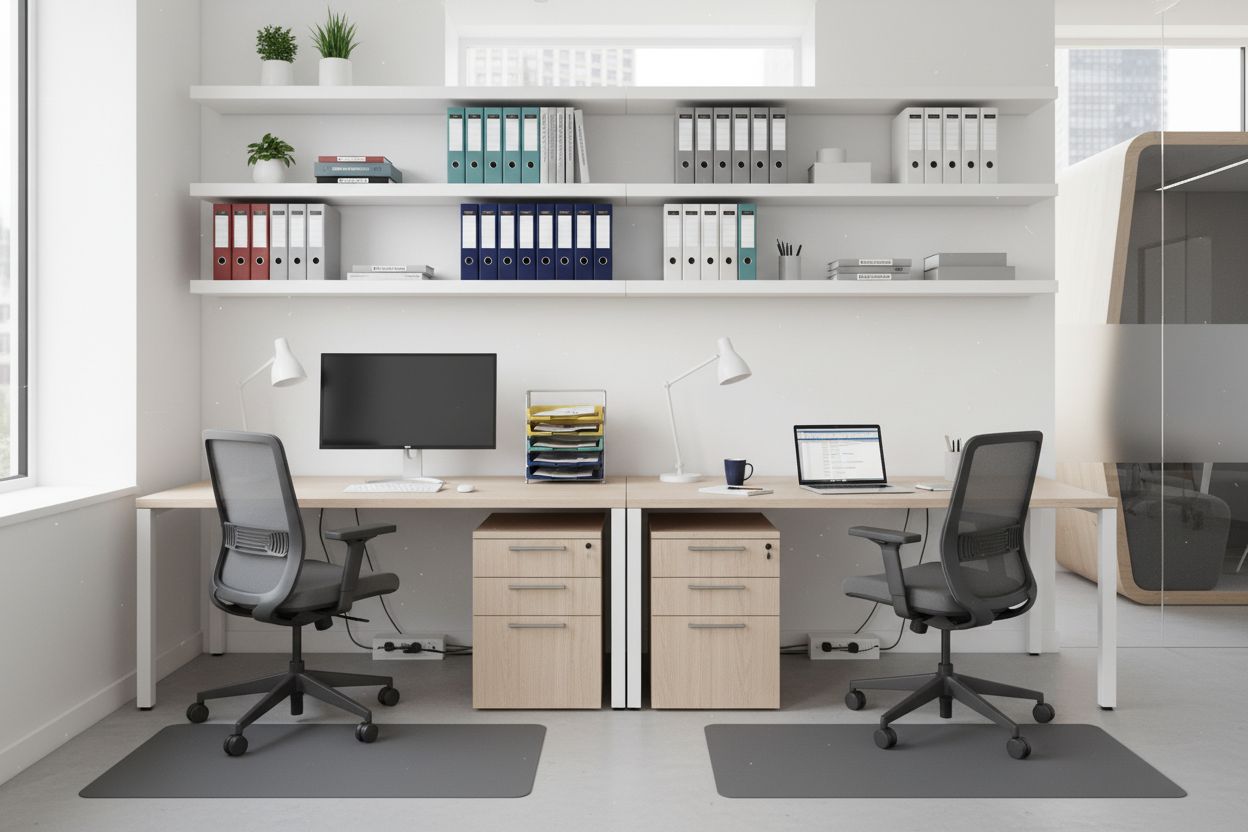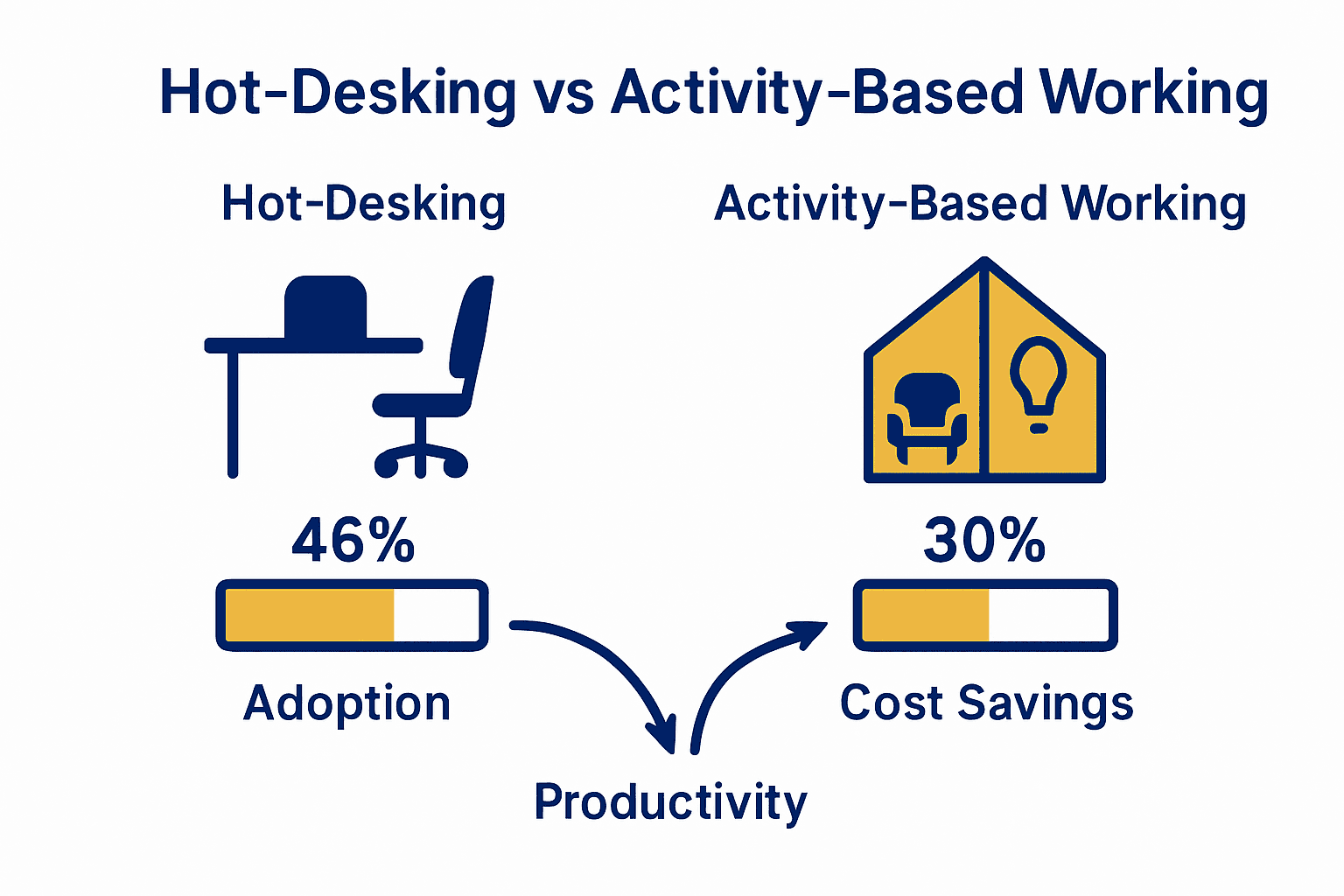Did you know that poorly organized office spaces can lower employee productivity by up to 15 percent? The way a workspace is planned and maintained shapes everything from daily focus to long-term job satisfaction. Smart organization strategies turn offices into places where people feel motivated, comfortable, and ready to work. Understanding the fundamentals of effective office design empowers businesses to improve performance, well-being, and make every square foot count.
Key Takeaways
| Point | Details |
|---|---|
| Space Utilization | Effective office organization is strategic, focusing on creating adaptive work environments that enhance employee performance and well-being. |
| Flexible Layouts | Innovative approaches like hot-desking and activity-based working enable organizations to optimize space utilization and promote diverse work styles. |
| Acoustic Design | Managing noise and creating varied acoustic zones are essential for minimizing distractions and improving workplace focus. |
| Continuous Improvement | Office organization should be a proactive, ongoing process; employing smart storage solutions and adaptable spaces can significantly boost productivity and employee satisfaction. |
Table of Contents
- Defining Office Space Organization Fundamentals
- Types of Office Spaces and Layout Strategies
- Key Elements of Effective Workspace Planning
- Legal, Safety, and Compliance Considerations
- Role of Commercial Floor Mats in Organization
- Common Pitfalls and Expert Organization Tips
Defining Office Space Organization Fundamentals
Office space organization is more than just arranging furniture and setting up workstations. It’s a strategic approach that transforms physical environments into productive, efficient, and employee-friendly spaces. Space utilization isn’t just about maximizing square footage – it’s about creating adaptive work environments that support employee performance and well-being.
According to Gable’s research on office space planning, effective organization begins with comprehensive activity-based working zones. These dynamic spaces are designed to support different work styles and tasks:
- Collaborative areas for team interactions
- Quiet zones for focused individual work
- Flexible infrastructure that can be easily reconfigured
- Acoustic strategies to manage noise and improve concentration
Successful office space organization requires data-driven decision-making. This means analyzing occupancy patterns, understanding employee workflow, and creating environments that adapt to changing business needs. The goal is not just aesthetic appeal, but creating spaces that genuinely enhance productivity, employee satisfaction, and organizational efficiency.

Key organizational principles include designing for flexibility, promoting employee wellness, and ensuring each square foot serves a strategic purpose. By treating office space as a dynamic ecosystem rather than a static layout, businesses can create environments that inspire creativity, support collaboration, and optimize overall workplace performance.
Types of Office Spaces and Layout Strategies
Modern office design has evolved far beyond traditional cubicle landscapes, introducing flexible and dynamic workspace configurations that adapt to changing organizational needs. Hot-desking and activity-based working have emerged as revolutionary approaches that challenge conventional workspace assumptions, offering companies unprecedented flexibility and efficiency.
According to Wikipedia’s research on hot-desking, this innovative strategy enables organizations to achieve significant cost savings—up to 30%—by allowing employees to use desks on demand rather than maintaining dedicated workstations. Around 60% of North American companies have already adopted this approach, recognizing its potential to optimize office space utilization.
Gable’s office space planning research highlights activity-based working as a transformative strategy that replaces one-size-fits-all layouts. This approach creates specialized zones designed for different work modes:
- Collaborative spaces for team interactions
- Quiet areas for focused individual work
- Private zones for confidential discussions
- Social spaces for informal networking
These strategic layout designs are supported by modular furniture and advanced booking technologies that match workspace configurations to actual usage patterns. By providing diverse environments tailored to specific tasks, organizations can enhance productivity, employee satisfaction, and spatial efficiency. The key is creating adaptable spaces that support various work styles while maintaining a cohesive and engaging workplace ecosystem.
Here’s a comparison of the most common office space layout strategies:

| Layout Strategy | Key Features | Ideal Use Cases |
|---|---|---|
| Hot-Desking | Desks used as needed Flexible seating Supports hybrid work |
Companies seeking cost savings Organizations with remote teams |
| Activity-Based Working | Specialized zones Adaptable spaces Focus on tasks |
Teams needing collaboration and focus Firms with varied work styles |
| Traditional Cubicles | Fixed workstations High privacy Defined personal space |
Companies requiring confidentiality Workplaces needing quiet zones |
| Open Plan | Minimal barriers Maximizes collaboration Modern appeal |
Creative industries Startups seeking flexible interaction |
Key Elements of Effective Workspace Planning
Creating an effective workspace goes beyond mere aesthetic considerations. It’s a strategic process that demands careful analysis and thoughtful design to support employee productivity, comfort, and organizational goals. Space utilization stands at the core of this approach, with successful companies targeting an optimal 40-60% workspace occupancy rate that balances efficiency and flexibility.
Gable’s office space planning research reveals critical elements that transform ordinary offices into high-performance environments. A paramount concern is managing acoustic design – an often overlooked factor where 48% of employees report noise as their top focus disruption. This means creating spaces that intelligently manage sound transmission and provide varied acoustic zones.
Key workspace planning strategies include:
- Smart spatial configuration to maximize usable area
- Integrated acoustic and privacy solutions
- Maximizing natural light exposure
- Implementing modular, adaptable infrastructure
- Utilizing real-time occupancy tracking for continuous optimization
The most successful workspace designs embrace flexibility, recognizing that different tasks require different environments. By leveraging data-driven insights and creating responsive layouts, organizations can craft workspaces that not only meet current needs but anticipate future workplace evolution. Check out our guide on current office design trends to stay ahead of workplace transformation strategies.
Legal, Safety, and Compliance Considerations
Navigating the legal landscape of office space design requires a comprehensive understanding of various regulatory requirements that protect employee health, safety, and accessibility. Workplace compliance is not just about following rules – it’s about creating environments that prioritize human well-being and organizational responsibility.
According to Wikipedia’s research on break room regulations, while U.S. federal law does not mandate employers to provide break rooms, these spaces must still adhere to critical accessibility standards. The U.S. Access Board requires that such areas be fully accessible to people with disabilities, and the Occupational Safety and Health Administration (OSHA) classifies break rooms as common areas subject to general safety standards.
Key compliance considerations include:
- Ensuring accessibility for all employees
- Maintaining clear emergency exit pathways
- Implementing proper ergonomic design
- Creating safe and clean common areas
- Meeting Americans with Disabilities Act (ADA) guidelines
Commercial floor safety research highlights the importance of detailed safety standards, particularly for floor surfaces. Commercial floor mats play a crucial role in workplace safety, with specific requirements including:
- Non-slip backing
- High durability
- Compliance with industry safety regulations
- Maintaining cleanliness and reducing slip hazards
Learn more about ADA-compliant floor solutions that can help businesses create safer, more inclusive workplace environments. Proactive compliance isn’t just about avoiding penalties – it’s about demonstrating a genuine commitment to employee safety and organizational excellence.
Role of Commercial Floor Mats in Organization
Commercial floor mats are far more than simple decorative accessories – they are strategic organizational tools that simultaneously enhance safety, cleanliness, and professional aesthetics. Floor management goes beyond appearance, serving multiple critical functions that directly impact workplace efficiency and employee experience.
According to Mats That Matter’s research, commercial floor mats perform multiple essential roles in organizational spaces. These versatile solutions include:
- Interior walk-off mats that capture dirt and moisture
- Anti-fatigue mats supporting employee comfort
- Logo mats reinforcing brand identity
- Slip-resistant surfaces improving workplace safety
Prudential Uniforms’ facility management research highlights the comprehensive benefits of strategic mat placement. Many organizations now utilize rental service programs that ensure regular cleaning, optimal placement, and continuous mat maintenance. These programs not only improve safety and aesthetics but also significantly reduce upfront purchasing costs.
Beyond functional benefits, commercial mats contribute to organizational branding and first impressions. Learn more about commercial entrance matting strategies to transform these seemingly simple floor coverings into powerful communication and safety tools. By thoughtfully selecting and maintaining floor mats, businesses can create welcoming, professional environments that prioritize both employee well-being and organizational image.
Common Pitfalls and Expert Organization Tips
Effective office organization is an art form that requires strategic thinking and proactive planning. Many businesses stumble by treating workspace design as an afterthought, failing to recognize how workspace configuration directly impacts productivity, employee morale, and operational efficiency.
Coohom’s research on workspace organization reveals critical strategies for transforming chaotic environments into streamlined, high-performance spaces. Expert recommendations include:
- Implementing vertical storage solutions like floating shelves
- Utilizing hidden under-desk storage options
- Developing comprehensive cable management systems
- Investing in dual-purpose furniture
- Adopting color-coded filing methods
- Creating minimalist desk setups to reduce visual clutter
Common organizational pitfalls often stem from reactive rather than proactive approaches. Businesses frequently overlook the importance of creating adaptable spaces that can evolve with changing workplace dynamics. Clutter accumulation, inefficient storage, and poor spatial planning can significantly diminish workplace productivity and create unnecessary stress for employees.
Understanding current office design trends can help organizations stay ahead of workspace challenges. The key is to view organization not as a one-time task, but as an ongoing process of continuous improvement. By implementing smart storage solutions, embracing minimalist design principles, and creating flexible work environments, businesses can create spaces that not only look professional but actively support employee performance and well-being.
Transform Chaos into Productivity with the Right Floor Mat Solutions
Office space organization can feel overwhelming when clutter, noise, and safety hazards threaten both your workspace and your team’s productivity. As highlighted in this guide, issues like poor floor management, disruptive noise, and insufficient accommodation for high-traffic areas can sabotage even the best-designed layouts. A key principle from the article is smart space utilization, including the use of strategic commercial mats to support organization, safety, and aesthetics.
Ready to solve these challenges for good? Explore durable, high-performance commercial matting solutions that help reduce clutter, prevent slips, and make your space instantly more welcoming. Take action now to support your efforts in office transformation. Visit Mats4U.com to browse a full selection of industry-proven products. For ideas on making your entryway safer and more professional, discover our tips in this resource on entrance matting for commercial spaces. Create an organized, safe environment that truly reflects your business standards today.
Frequently Asked Questions
What are the key elements of effective workspace planning?
Effective workspace planning involves smart spatial configuration, integrated acoustic solutions, maximizing natural light, modular infrastructure, and real-time occupancy tracking. These elements help create a comfortable and efficient work environment.
How does activity-based working benefit organizations?
Activity-based working creates specialized zones tailored for different tasks, allowing employees to choose environments that suit their work style. This approach enhances collaboration, focus, and overall productivity within teams.
What should organizations consider for workplace compliance and safety?
Organizations must ensure accessibility for all employees, maintain clear emergency exit paths, implement ergonomic designs, and adhere to safety standards, including those outlined by the Americans with Disabilities Act (ADA).
How can commercial floor mats improve office space organization?
Commercial floor mats enhance office organization by capturing dirt and moisture, providing anti-fatigue support, reinforcing brand identity with logo mats, and improving workplace safety through slip-resistant surfaces. Strategically placed mats contribute to a cleaner, safer, and more professional environment.
Recommended
- Understanding Current Office Design Trends for 2023 – Mats4U USA
- Office Productivity Hacks: Complete Guide for Businesses – Mats4U USA
- Understanding Employee Break Room Ideas for Better Workplaces – Mats4U USA
- 7 Essential Facility Management Best Practices for 2025 – Mats4U USA
- Home Office Organization Ideas for Stylish and Tidy Spaces 2025 – BLUSHBEES USA







